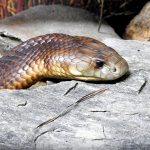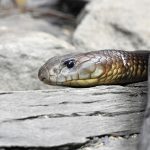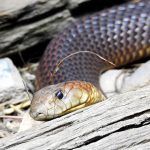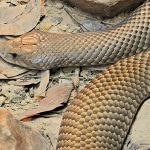KING BROWN SNAKE
A Tale of Survival in Australia’s Heartland
Imagine walking across the sun-baked earth of Australia’s vast interior. The air shimmers with heat, and the land stretches endlessly, dotted with hardy shrubs and ancient rocks. Beneath your feet, hidden from sight, an extraordinary creature glides through the world—both feared and misunderstood. This is the story of the King Brown Snake, also known as the Mulga Snake.
Profile at a Glance
| Feature | Description |
|---|---|
| Common Name | King Brown Snake / Mulga Snake |
| Scientific Name | Pseudechis australis |
| Size | 2 – 2.5 metres (sometimes larger) |
| Habitat | Arid & semi-arid zones, grasslands, scrubland, woodland |
| Distribution | Western Australia, Northern Territory, South Australia, Queensland, parts of NSW |
| Diet | Mammals, reptiles (even other snakes), birds, amphibians |
| Venom | Potent, primarily neurotoxic and potentially life-threatening |
| Disposition | Shy, generally avoids confrontation; defensive if provoked |
Life in the Arid Lands
The King Brown Snake is a true survivor. Its kingdom spans much of inland Australia, thriving where few others can—across deserts, dry grasslands, rocky ridges, and woodland edges.
Visual and Multi-Sensory Description
- Sight: Picture an impressively long, slender serpent, its glossy scales gleaming in shades of chocolate, copper, and sometimes a warm reddish-pink. Its head is broad and distinct, merging smoothly with a powerful, muscular body.
- Touch: If you could (safely) slide your fingers gently across its back, you’d feel smooth, firm, cool scales arranged like polished armour.
- Sound: In danger, it produces a sharp, intimidating hiss—an urgent warning to keep your distance.
- Smell: The King Brown Snake is nearly scentless, moving with deliberate grace, perfectly suited to stalking prey or avoiding danger in its dry, earthy environment.
Adaptations
- Seeks shelter in deep animal burrows and crevices during heatwaves or cold snaps.
- Its colours blend perfectly with the outback, providing camouflage from both predators and prey.
- Able to go for lengthy periods without food, particularly during the harshest months.
Hunter and Hunted: The Diet of a King
The King Brown Snake’s menu is varied and opportunistic. As the day cools, it emerges in search of food:
- Rodents and rabbits: Essential for controlling invasive populations.
- Birds and lizards: Swift and cunning, requiring patience and precision.
- Other snakes: It is not uncommon for them to prey on reptiles, including venomous ones!
Occasionally, a deep run burrow will echo with the faint rustling of prey—soon to be captured by the unerring strike of the Mulga Snake.
Venom and Human Encounters
The word “venomous” can spark fear, but the King Brown Snake is not inherently aggressive toward people. Its venom is powerful, acting primarily on the nervous system, and can be life-threatening without treatment. Human fatalities are rare thanks to increased awareness and prompt medical care.
Defensive Behaviour
- When startled, it flattens its neck and raises its head, hissing with conviction.
- Left undisturbed, most snakes will slip quietly away into cover, unseen.
- Bites generally occur only when the snake is accidentally stepped on or deliberately harassed.
If you encounter a King Brown Snake:
Stay calm. Observe from a respectful distance. Never attempt to handle or harm it.
Conservation and Coexistence
The King Brown Snake plays a crucial role in the balance of Australia’s ecosystems:
- Pest Control: By keeping rodent and rabbit numbers in check.
- Indicator Species: Their presence reflects a healthy and functioning ecosystem.
- Biodiversity: As predators and prey, they are integral to the web of life.
However, habitat loss, changes in land use, and persecution still threaten their numbers in some regions.
To glimpse a King Brown Snake in the wild is to witness a marvel of adaptation and resilience. Let us remember that every creature, no matter how misunderstood, has a vital role to play in nature’s intricate design.
By learning about and respecting the King Brown Snake, we become mindful guardians of Australia’s vibrant natural heritage.
Remember:
Appreciate wildlife from afar. If you see a snake, give it space to move on in peace. Your curiosity is the first step towards conservation.




